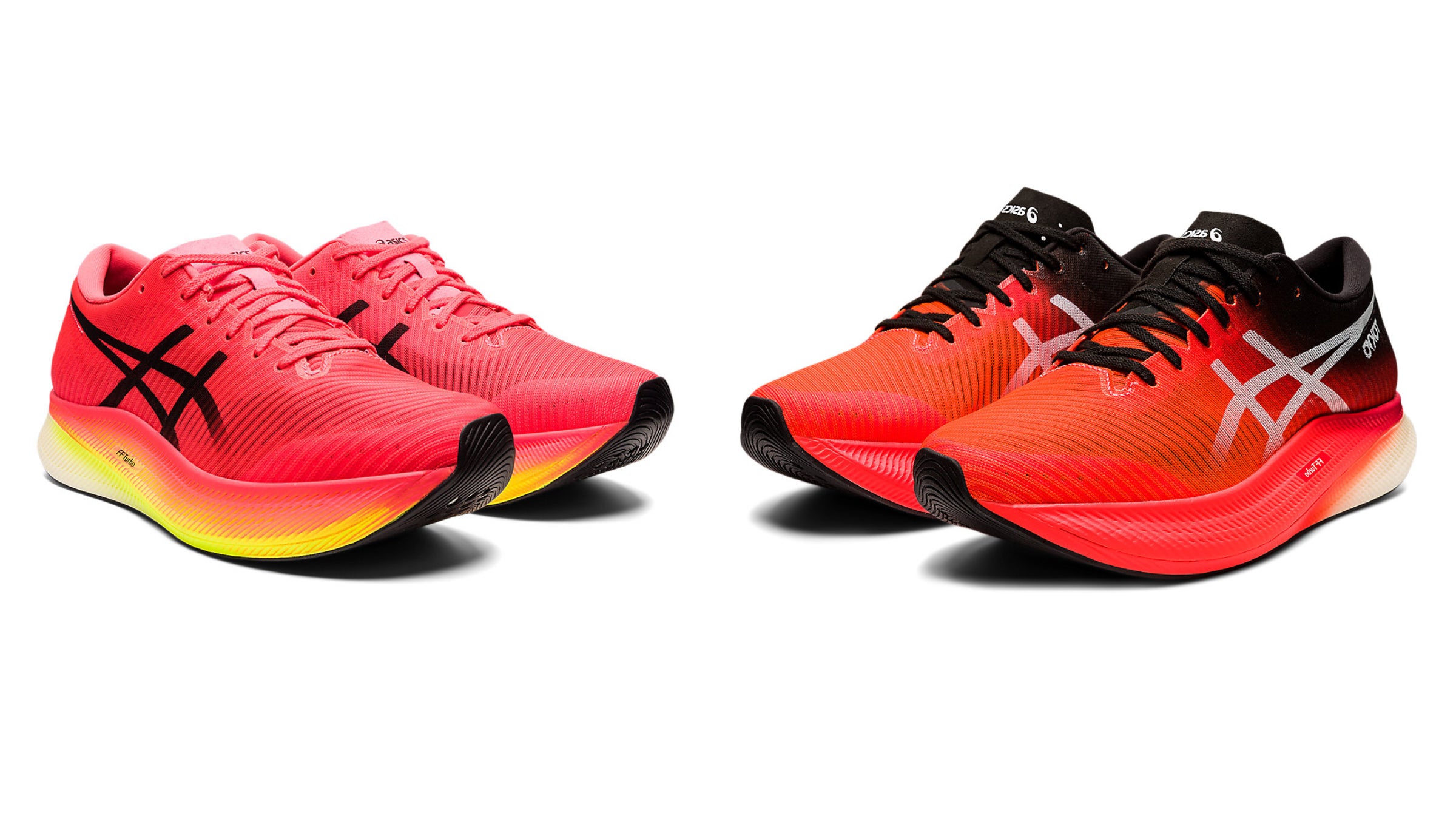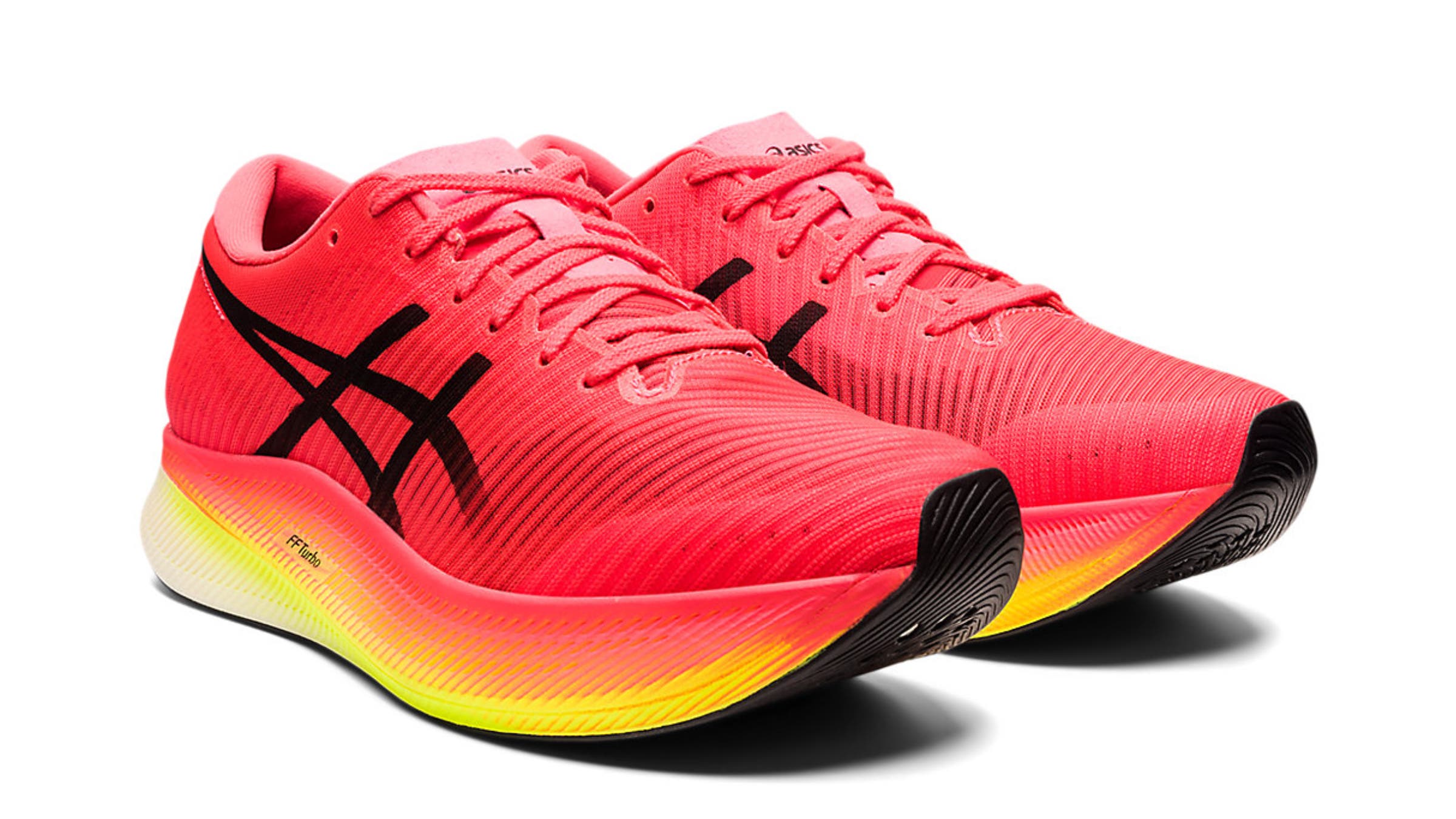Face-Off: Asics MetaSpeed Sky vs. MetaSpeed Edge

Asics took a unique and welcome approach to bifurcating its supershoe line. In contrast to competitors who divided their mega-midsole, carbon fiber-plated, lightweight foam, rocker-soled racing shoes into fast and faster categories, Asics split theirs into “longer-strided” vs “higher-cadence” supershoes. We tested both in a side-by-side comparison to weigh in on the differences and help you decide which to choose.
MetaSpeed Sky

$250
Weight 7.0 oz.
33 mm heel/ 28 mm forefoot, drop 5 mm
What: A race-ready supershoe that is both energy efficient and well cushioned with an emphasis on lengthened strides, so you can run faster at the same turnover rate. This is a lightweight shoe with an energetic return that seeps into itself with each step, yet quickly bounces back in a balanced and efficient response. The carbon plate helps to stabilize the FLYTEFOAM Turbo midsole material—Asics’ lightest and most responsive foam—with a rocker that’s more gradual than other super shoes and more pronounced than its equivalent shoe, the MetaSpeed Edge we’ll talk about below.
Pros: The Sky is both absorbing and bouncy underfoot with a lightweight, energetic feel that comes across as balanced and efficient. The responsive foam is softer than that of many other supershoes but doesn’t feel sloppy. The rocker is less gradual than that of the sibling Edge and helps propel you forward for a longer trajectory.
Cons: The 100% recycled polyester engineered mesh upper feels a bit plastic-y but it doesn’t retain water, although the old-school laces do—even though they are exceptionally functional. The toe box isn’t as wide as shoes built for splay, but wider than most racing-oriented shoes and, given the stretch of the breathable polyester, had enough play in the material that they didn’t create any tight or hot spots.
This Is For: The Sky was designed to extend stride length while keeping cadence consistent. They accomplish this through the energetic midsole foam that it stabilizes with a sharply-curved, rigid full-length carbon plate that reduces ankle flexion. Encouragement to stretch your gait comes from a combination of a long-feeling rocker and an increased late-stage curve that kicks in under the toes, when the foot is pushing off, coaxing striding out from hip extension. As a nice touch, the low 5mm drop limits overstriding by discouraging heel striking and rewarding forefoot landing with an energetic response.
MetaSpeed Edge

$250
Weight 6.6 oz.
29mm heel/ 21mm forefoot, drop 8mm
What: This most certainly is also a supershoe but, with a lower profile, it feels a little less “super” and runs closer to a racing flat. Designed for high cadence, the Edge’s rocker is more gradual than that of the Sky and the toe slant felt more shallow in comparison. The carbon plate is tuned to feel like a more rigid diving board, compared to the springier plate of the Sky.
Pros: These corner better than any other super shoe on the market and also work well off the bike because they are tuned to work with less bounce or spring, which often gets drained from the legs by T2. The FLYTEFOAM Blast midsole is both resilient and dampening with plenty of responsiveness for high cadence running and the ASICSGRIP outsole with lightweight rubber has a dependable grip, even on wet pavement.
Cons: The Edge is not as cushioned a ride and for those who like the bounce and responsiveness of supershoes they may feel less lively. They also suffer the upper issues of the Sky.
This Is For: The Edge is for high-cadence runners who run with an up-tempo RPM. The Edge enables quick starts off the bike, rather than depending on tired legs to miraculously revive themselves.
Winner!
The Edge takes it with a lean at the finish for triathletes. While both the Sky and Edge are supershoes, the Sky is designed for greater rebound via a taller stack height and more bounce power while the Edge’s lower midsole is geared for higher turnover and quick transitions. It is more of a staccato experience, like running on hot coals, and that’s more consistent with a triathlete’s gait off the bike.